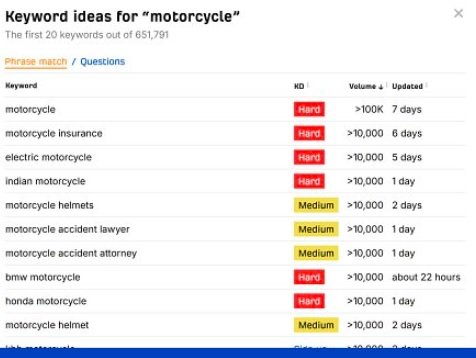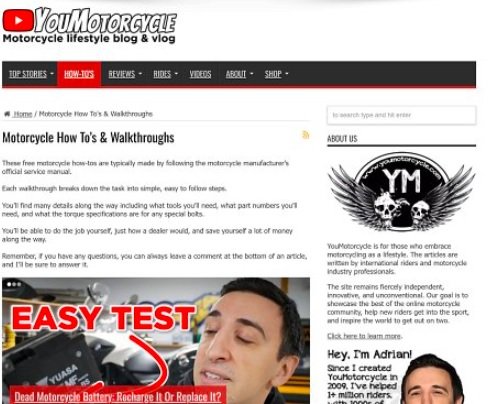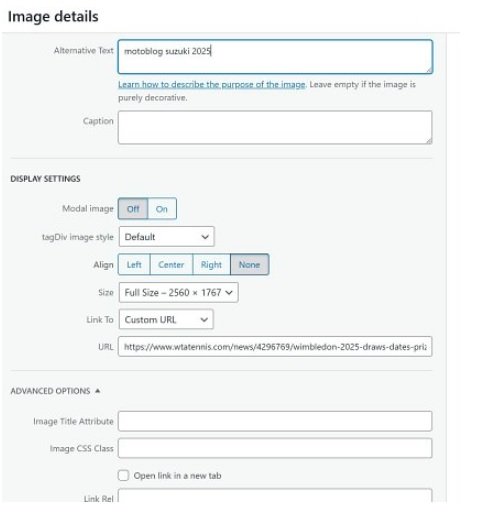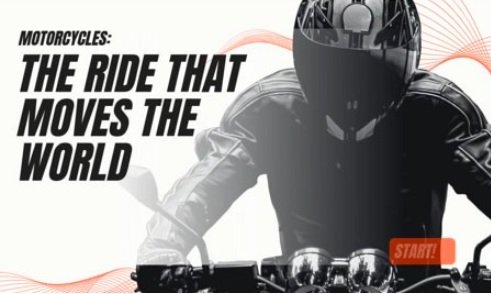Many motorcycle bloggers face challenges like slow audience growth or finding quality content ideas, but looking at successful sites can help. For example, Revolution Motorcycle Marketing showcases expert reviews, riding tips, and real-world stories from riders around the globe, offering inspiration for creating engaging content. By learning from these examples and focusing on valuable insights, helpful guides, and compelling storytelling, you can make your motorcycle blog more discoverable, engaging, and a go-to hub for passionate riders around the world.
Understanding SEO Basics for Motorcycle Bloggers

If you run a motorcycle blog, you’ve probably heard about SEO, but it can feel confusing at first. Simply put, SEO (Search Engine Optimization) is the practice of improving your blog so it ranks higher on Google and other search engines. This is especially important for motorcycle content, whether you’re writing about bike maintenance, touring routes, gear reviews, or riding tips. Good SEO ensures your posts reach the right audience — riders who are actively searching for the information you provide.
Google decides which pages to show at the top based on several factors:
- Content relevance: How well your page matches the user’s search query.
- Authority: The credibility of your site, influenced by backlinks and online reputation.
- User experience: Site speed, mobile-friendliness, and ease of navigation.
For motorcycle bloggers, SEO is more than just a technical tool — it’s a way to share your passion with people who are looking for it. Without it, even the most detailed reviews or travel guides may remain unseen. With proper optimization, your blog can attract loyal readers who are genuinely interested in motorcycles.
How SEO Works: Key Areas to Focus On
To improve your blog’s SEO, you need to focus on three main areas:
On-Page SEO
- Optimize keywords naturally in titles, headings, and content.
- Write clear meta descriptions to summarize your posts.
- Include internal links to guide readers to related content.
Off-Page SEO
- Build backlinks from reputable motorcycle sites, forums, or guest posts.
- Encourage social sharing to increase visibility and credibility.
Technical SEO
- Improve site speed and mobile responsiveness.
- Repair broken links to ensure a seamless user experience.
- Submit sitemaps to help search engines index your content efficiently.
Why SEO Matters for Motorcycle Blogs
SEO allows niche blogs to compete with larger motorcycle websites. By focusing on specific topics, your blog can attract the exact readers who want your content. For example:
- How-to guides on upgrading bike parts
- Reviews of touring routes or gear
- Tips for long-distance riders or commuting bikers
Strong SEO ensures that your content doesn’t just exist online — it gets discovered, read, and shared by enthusiasts.
Understanding Your Target Audience
Knowing your audience is crucial for effective SEO. Motorcycle readers are diverse:
- Commuters: Look for affordable maintenance and practical riding tips.
- Weekend riders: Interested in scenic routes, gear, and community events.
- Adventure riders: Seek long-distance touring advice, safety tips, and packing guides.
By understanding what your readers want, you can create content that answers their questions and keeps them returning for more.
Keyword research is one of the most important steps for a successful motorcycle blog. It helps you understand what riders are searching for and ensures your content aligns with their needs. Without proper keyword research, even the best-written posts may remain unseen. By targeting the right search terms, you can attract readers who are genuinely interested in motorcycles, bike maintenance, touring, and gear reviews.
Why Keyword Research Matters for Motorcycle Blogs
Keyword research allows you to:
- Identify what topics riders are searching for online.
- Understand search intent to create content that answers questions.
- Drive organic traffic to your blog without paid advertising.
- Compete with larger motorcycle websites by focusing on niche topics.
How to Find Motorcycle-Related Keywords

There are several tools to discover high-value keywords for your blog:
- Google Keyword Planner: Provides search volume and competition data.
- Ubersuggest: Shows related keywords and trends in the motorcycle niche.
- Ahrefs: Offers comprehensive insights, including keyword difficulty, backlinks, and competitor analysis.
By using these tools, you can find keywords that match your blog’s content and attract the right type of traffic.
Long-Tail Keywords for Motorcycle Blogs
Long-tail keywords are longer, more specific search phrases. They usually have lower competition and attract visitors with higher engagement. Examples include:
- For touring content: “best touring motorcycles for beginners,” “motorcycle road trips in Europe”
- For maintenance guides: “DIY motorcycle oil change guide,” “how to replace motorcycle brake pads”
These specific phrases help you reach readers who are actively looking for detailed information and are more likely to interact with your content.
Using Intent-Based Keywords Effectively
Understanding search intent ensures your content meets readers’ needs:
- Informational keywords: Users are seeking advice or tutorials, e.g., “how to maintain a motorcycle chain.”
- Transactional keywords: Users are ready to buy or take action, e.g., “best motorcycle helmets to buy online.”
- Commercial/Research keywords: Users are comparing options, e.g., “Suzuki Boulevard M50 vs Harley Softail comparison.”
Matching keywords with the right intent improves engagement and increases the chance that visitors stay on your site longer.
Where to Place Keywords on Your Blog
Strategic keyword placement helps search engines understand your content and improves rankings:
- Titles: Include primary keywords naturally in blog post titles.
- Headings (H1, H2, H3): Use secondary or long-tail keywords to structure content.
- Meta descriptions: Summarize posts with keywords to improve click-through rates.
- Alt tags for images: Describe images with relevant keywords, e.g., “Suzuki Boulevard M50 side view.”
- Internal linking: Link to related posts to guide readers and strengthen SEO.
Examples of Effective Motorcycle Keywords
- Travel riders: “motorcycle road trips in Europe,” “best scenic motorcycle routes”
- Maintenance blogs: “DIY motorcycle oil change guide,” “motorcycle tire pressure tips”
- Bike reviews: “Suzuki Boulevard M50 review,” “Harley Davidson Street Glide pros and cons”
Using research tools, long-tail keywords, intent-based strategies, and smart placement ensures your content reaches the right audience and ranks higher in search engines.
Creating SEO-Friendly Motorcycle Blog Content: A Step-by-Step Guide

High-quality content is the heart of any successful motorcycle blog. Writing engaging, informative, and SEO-optimized posts not only attracts readers but also helps your site rank higher in Google. Whether you’re sharing riding stories, gear reviews, or route guides, following a structured process ensures your content performs well and keeps readers coming back.
Step 1: Understand Your Audience and Purpose
Before writing, know who you’re targeting:
- Commuters: Looking for practical tips and maintenance advice.
- Adventure riders: Interested in touring routes, long-distance tips, and gear recommendations.
- Casual enthusiasts: Reading bike reviews, event coverage, and lifestyle stories.
Understanding your audience enables you to select the appropriate tone, keywords, and content type. Ask yourself: What problems does my reader want to solve? What questions are they asking online
Step 2: Conduct Keyword Research
Keyword research forms the foundation of SEO-friendly content. Use tools like:
- Google Keyword Planner for search volume and trends.
- Ubersuggest for related keywords and suggestions.
- Ahrefs for competitor keyword analysis.
Focus on long-tail and intent-based keywords:
- Informational: “How to maintain a motorcycle chain”
- Transactional: “best motorcycle helmets to buy online”
- Commercial: “Suzuki Boulevard M50 review vs Harley Softail”
Place primary keywords in titles, headings, meta descriptions, and naturally throughout the article.
Step 3: Create an Outline for Your Post
A clear structure improves readability and SEO. Consider this format:
- Introduction: Hook readers with a question, story, or problem.
- Main sections: Use H2 and H3 headings to organize content.
- Riding experiences (storytelling)
- Gear or motorcycle reviews (informative content)
- Route or maintenance tips (practical guides)
- Riding experiences (storytelling)
- Conclusion: Summarize key takeaways and include a call-to-action (CTA).
An outline ensures your article flows logically and makes it easier for readers and search engines to understand.
Step 4: Write High-Quality, Engaging Content
Content should be informative, engaging, and easy to read:
- Balance storytelling (riding experiences, trips, adventures) with practical information (gear reviews, bike maintenance, route suggestions).
- Keep sentences concise and paragraphs short to improve readability.
- Use bullet points and numbered lists for tips, instructions, or steps.
- Include examples or personal experiences to make your posts relatable.
Step 5: Optimize for Readability and SEO
SEO-friendly content is also reader-friendly:
- Use H1 for the title, H2 for main sections, and H3 for subpoints.
- Break up text with headings, bullet points, and short paragraphs.
- Include internal links to relevant posts, e.g., other bike reviews, route guides, or maintenance tips.
- Add external links to authoritative sites when necessary to improve credibility.
- Make your meta description compelling and keyword-rich.
Step 6: Add Multimedia to Enhance Engagement
Visual content improves dwell time, understanding, and shareability:
- Images: Include high-quality photos of motorcycles, routes, or gear.
- Videos: Share ride footage, tutorials, or review demonstrations.
- Infographics: Use diagrams for maintenance tips or comparison charts.
Step 7: Edit, Proofread, and Optimize
Before publishing:
- Check for grammar, spelling, and readability.
- Ensure keywords appear naturally, not forced.
- Verify all links (internal and external) work correctly.
- Test page speed and mobile responsiveness for a smooth user experience.
Step 8: Publish and Promote
Once your post is ready:
- Share it on social media platforms and motorcycle forums.
- Include it in newsletters or email campaigns to your subscribers.
- Engage with readers through comments to build community and encourage sharing.
Image Optimization for Motorcycle Blogs

Motorcycle blogs often rely heavily on visuals — from high-quality bike photos to scenic riding routes. Optimizing these images for SEO is crucial because they can significantly impact your blog’s performance in search engines and user experience. Large, unoptimized images can slow down your site, leading to higher bounce rates and lower rankings, while well-optimized visuals can improve load times, accessibility, and even drive additional traffic through Google Image Search.
Here are key strategies for effective image SEO on your motorcycle blog:
- Use descriptive file names: Instead of generic names like “IMG_1234.jpg,” use specific, keyword-rich names such as “custom-harley-davidson-bike.jpg” or “yamaha-mt09-tour-ride.jpg.” This helps search engines understand the content of your images.
- Add meaningful alt tags: Alt text not only improves accessibility for visually impaired readers but also provides context to search engines. A good alt tag describes the image accurately, e.g., “red Ducati Monster parked on a mountain road.”
- Compress images for faster loading: Large images can slow down your blog, hurting both user experience and SEO. Tools like TinyPNG, ShortPixel, or ImageOptim can reduce file size without sacrificing quality.
- Choose the right format: JPEGs are ideal for photos, PNGs work well for graphics with transparency, and WebP offers high-quality compression for web use. Choosing the correct format helps your pages load faster.
- Leverage image search for extra traffic: Optimized images can appear in Google Image Search, bringing in visitors who may not find your site through traditional search results. Include relevant captions and context around your images to increase the chances of ranking.
By following these image optimization techniques, your motorcycle blog will not only look great but also perform better in search rankings. Properly optimized visuals make your content more engaging for readers and provide additional opportunities to attract organic traffic from image searches, helping your blog grow in both reach and authority.
Technical SEO for Motorcycle Bloggers: Boost Site Speed, Performance, and Rankings

Technical SEO is the foundation of a high-performing motorcycle blog. Even the best content can struggle to rank if your website has slow loading times, poor mobile responsiveness, or weak security. By optimizing your technical setup, you improve user experience, increase dwell time, and signal to Google that your site is trustworthy and reliable.
Why Technical SEO Matters for Motorcycle Blogs
Motorcycle blogs often feature high-resolution images, videos, and multimedia content, which can slow down your site if not optimized. Technical SEO ensures that:
- Pages load quickly for desktop and mobile users.
- Your site is secure, fast, and accessible.
- Search engines can crawl, index, and display your content effectively.
A technically sound blog not only helps with rankings but also keeps readers engaged.
Optimizing Core Web Vitals for Better Rankings
Core Web Vitals are Google’s key metrics for measuring user experience. Focus on:
- Largest Contentful Paint (LCP): Make sure your main content loads quickly. Compress images, use optimized formats, and reduce server response time.
- First Input Delay (FID): Improve page interactivity by minimizing JavaScript and avoiding heavy scripts.
- Cumulative Layout Shift (CLS): Prevent layout shifts by setting fixed sizes for images and ads.
Optimizing these metrics can improve search visibility and reduce bounce rates.
Implementing Structured Data
Structured data (schema markup) helps search engines understand your content and can enhance your search listings with rich snippets. For motorcycle blogs, consider using:
- Article schema for blog posts and reviews.
- Product schema for gear reviews or bike comparisons.
- Breadcrumb schema for better navigation in search results.
Properly structured data can increase click-through rates by making your listings more visually appealing and informative.
Sitemap and Robots.txt Setup

A sitemap helps search engines discover all pages on your site, while the robots.txt file controls which pages are crawled. Key tips include:
- Create an XML sitemap and submit it to Google Search Console.
- Ensure your sitemap includes all important posts, categories, and pages.
- Configure robots.txt to prevent the indexing of unnecessary or duplicate pages.
This setup improves crawl efficiency and ensures that all valuable content is discoverable.
Speed and Performance Enhancements
Motorcycle blogs often include heavy media like high-resolution images and videos. Optimizing technical performance involves:
- Caching: Store static versions of pages to reduce server load.
- CDNs (Content Delivery Networks): Deliver content faster to users across different locations.
- Lazy Loading: Load images and videos only when users scroll to them.
- Image Optimization: Compress and resize images for faster page load.
Implementing these techniques ensures a faster, smoother browsing experience for readers, which is crucial for keeping them engaged.
Security and Mobile Responsiveness
- HTTPS: A secure site protects user data and is a ranking factor.
- Mobile-first design: Ensure your theme is responsive and readable on smartphones and tablets.
- Regular updates: Keep plugins, themes, and WordPress core up to date to prevent vulnerabilities.
A secure, mobile-friendly blog not only boosts SEO but also builds trust with your readers.
Running a successful motorcycle blog isn’t just about passion for bikes — it’s about making sure your content reaches the right audience. By understanding SEO basics, conducting thorough keyword research, writing engaging posts, and optimizing technical performance, you can attract readers who are genuinely interested in motorcycles, riding tips, and gear reviews.
Key strategies to remember:
- SEO fundamentals: Optimize content relevance, authority, and user experience.
- Keyword research: Use long-tail and intent-based keywords to target riders effectively.
- Content creation: Balance storytelling, reviews, and practical guides for maximum engagement.
- Technical SEO: Improve site speed, mobile responsiveness, security, and structured data.
- Multimedia and links: Incorporate images, videos, and internal links to enhance usability and dwell time.
To see how a motorcycle blog applies these strategies successfully, check out YouMotorcycle Lifestyle and blog, which features a mix of reviews, ride stories, and how-to guides crafted for both readers and search engines. Studying well-structured posts like these can inspire your own content and help your blog stand out in the competitive motorcycle niche.



